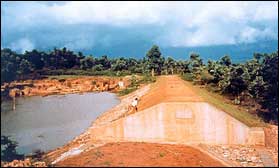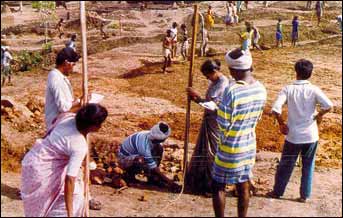 |
|
|
|
|
|
|
|
|
|
|
|
|
|
|
|
|
|
|
|
|
|
|
|
|
|
|
|
|
|
|
|
|
|
|
|
|
|
|
|
|
|
|
|
|
|
Palamau district lies in the northeastern corner of the once-fabled forest land of Central India. Though the average annual rainfall (128 cm) is good, the coefficient of variability is high and droughts are a common feature. In 1993-94 the district administration approached People's Science Institute to help drought-proof the district. In response PSI undertook to implement Sukha Mukti Abhiyan (SMA). |
|
|
|
|
|
|
|
|
|
|
|
|
|
|
|
|
Sukha Mukti Abhiyan prepared village communities - with a large component of tribals - to plan and build small earthen dams to harvest rainwater. In normal rainfall years the harvested rainwater recharges the groundwater table. In drought years, the groundwater can be used for domestic needs and irrigation. The programme was structured as a three- way partnership in which village-level organizations called Pani Panchayats were the projects' managers, the district administration was the sanctioning authority and the PSI-led Pani Chetna Manch (a team of trained local youth) acted as the coordinating agency. |
|
|
|
|
|
|
|
|
|
|
|
|
|
 |
|
|
|
|
|
|
|
|
|
|
|
|
|
|
|
|
|
|
|
|
|
|
|
|
|
The guiding principles and operational elements of the programme were: |
|
|
|
|
|
|
-
Establishment of village-based peoples' organizations (Pani Panchayats) to supervise the project planning, execution and maintenance of the dams.
-
Shramdan by the beneficiaries to emphasize their stake in the project. Building on traditional knowledge and local skills.
-
Introduction of equity in the sharing of the resources generated.
-
Enhancement of self-reliance by contributions from Shramdan and equity agreements to a Gramkosh (Village Development Fund).
|
|
|
|
|
|
|
|
|
|
|
|
|
|
|
|
| The main features of SMA were: |
|
|
|
|
|
|
|
|
|
|
|
- Number of Pani Panchayats formed: 125 in 125 villages
- Number of dams started: 176
- Planned irrigation potential: ~ 4,500 acres
- Average cost/structure: ~ Rs 2,26,000
- Average height of dams: 20 ft (~ 6. 1m)
- Employment generated (person-days): ~ 10,00,000
- Deposits in Gramkoshs (Oct '95): Rs 7,68,884
- Number of structures completed: 143
- Mahila Vikas Sangathans (MVS) in: 24 villages
- Nurseries raised by MVS : 40
- Saplings raised in nurseries: ~ 6,50,000
- Plantations/afforestation area: 181 acres
- Fish farming projects: 21 villages
- Technical training: 680 persons
- Nurseries training: 349 women
- Investment sanctioned for dams: Rs 3,97,59,203
- Actual expenditure (dams): Rs 2,69,99,311
- Investment in nurseries and plantations: Rs 7,53,800
- PSI/PCM mobilization expenses: ~Rs 50,00,000
|
|
|
|
|
|
| |
"PSI's work in drought- proofing Palarnau district is a unique model that needs to be emulated in the rest of the country."
Shri Chandi Prasad Bhatt
"I would like to cite the example of Palamau district in Bihar where Pani Panchayats have been set up to harvest water and manage watersheds. With the help of traditional structures and modern scientific inputs, a drought-prone area has witnessed remarkable change and is now set on the path of sustainable development."
Prime Minister,
Shri Atal Bihari Vajpayee. |
|
|
|
|
|
|
|
|
|
|
|
|
|
|
|
|
|
|
|
|
|
|
|
|
|
|
|
|
|
|
|
The biggest achievement of Sukha Mukti Abhiyan was to win the people's trust and empower them to plan and implement development projects. A large local talent pool was created by training villagers to become barefoot engineers. Comprehensive administrative procedures were printed in the form of programme guidelines and issued officially by the Deputy Commissioner. These guidelines were explained to the villagers and followed diligently. A computer programme was developed to prepare the designs and estimates of the dams. This eliminated much of the subjectivity in the calculations. The scale and speed with which the programme was implemented was truly impressive. |
|
|
|
|
|
|
|
|
|
|
|
|
|
| |
|
|
| |
|
|
|
|
|
|
|
|
|
|
|
|
|
|
|
|
|
|
|
|
|
|
|
|
Over 80 per cent of the sanctioned structures were completed in less than three years. Community involvement and transparent procedures resulted in a saving of more than 30 per cent of the sanctioned costs. The irrigation investment rate was far below that required for big dams. The Ministry of Rural Development, GOI, adapted many of the procedures designed by PSI for SMA to formulate guidelines for the National Watershed Development Programme launched by it in 1995. |
|
|
|
|
|
|
|
|
|
|
|
|
|
|
|
|
|
|
|
|
|
|
|
|
|
|
|
|
|
|
|
|
|




